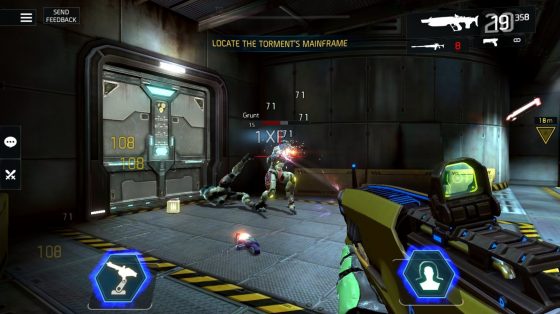Based on the old adage “imitation is the sincerest form of flattery,” we can only assume that mobile game developers are an incredibly complimentary bunch. Shadowgun, for instance, serves one purpose– to give iPhone and iPad users a Gears of War clone to call their own. Thankfully, the game succeeds relatively well.
Madfinger Games’ previous game was Samurai II: Vengeance, and the developer has a knack for providing high-quality, console-style games. Shadowgun definitely has some of the highest production qualities we’ve seen on a mobile device, and it’s an impressive example of what Apple’s hardware can do. For a game without a shred of creativity, it proves that fun gameplay trumps originality.
Shadowgun adapts the cover-based shooting mechanics of Gears of War nicely to the smaller, touchscreen platform and provides a fun, on-the-go alternative to the ultra-popular Xbox hit. For those unfamiliar with Gears, it’s a very cinematic sci-fi shooter where the action is based largely on taking cover behind obstacles to survive onslaughts of enemies.

Shadowgun looks, acts, and plays largely the same. Players take the role of John Slade, a mercenary in 2350 tasked with recovering Dr. Simon, a rogue scientist for Toltech Enterprises. Slade is a wisecracking, muscle-bound, armored brute of a man and Simon is the standard-issue mad scientist performing horrible experiments on people. Unlike the team-based Gears of War, in Shadowgun Slade goes it alone, with only the voice of his ship’s female AI to help guide him.
There’s clearly not a lot of emphasis on creativity here. It’s not hard to trace every single aspect of Shadowgun back to another game (or many other games). As a first effort to create something that brings a real console experience to the iPhone and iPad, however, there’s still a lot to like. First, the use of the licensed Unity 3D engine is stunning. While Unity doesn’t get that much attention in console or PC games, it can clearly compete with the Unreal engine in the mobile arena.
The character models look great, the levels are sharp and detailed, and while the game is largely a corridor-based shooter, the gorgeous backgrounds provide a grand sense of scale. The frame rate is impressively solid, even with multiple enemies on the screen. The game does have an annoying glitch that causes it occasionally to crash with no warning.

The controls are intuitive, using the standard dual-stick configuration: The left side of the screen moves Slade and the right side moves the camera. Controls can be sticky or over-sensitive in equal measure, though this is more likely due to the touchscreen than the game itself. To take cover, Slade simply runs up to an obstacle. Tapping forward causes Slade to leap over it, and tapping back moves him out of cover.
There are no evasive moves like rolls, and much like in Gears of War, Slade is a noticeably slow runner. Switching weapons and reloading is a simple tap away. Aiming and firing is seldom a problem with standard grunts, but tracking flying enemies highlights the slight sluggishness in the controls.
Enemies, which consist largely of mutated grunts, will take cover, but the AI is simplistic and mechanical. Bad guys will often just hang out, waiting to be shot, and provide challenge purely through numbers. Certain types of cover are destructible, but there’s a distinct lack of fine aiming, so even when an enemy is clearly visible behind cover and dead-set in Slade’s crosshairs, you never know if the hit will register.
It’s hard to tell if there’s a different effect based on where you shoot your enemies. Head and limb shots don’t seem to register any differently than body shots. The puzzles don’t extend far past finding big switches, but there are occasional electric locks that use a Simon-style mini game: A ten-digit number pad flashes a random sequence, and Slade must input the same sequence. For weapons crates, the sequence flashes past much faster than standard doors, but that’s the extent of non-shooting gameplay.
Shadowgun is clearly meant to impress gamers with its slick, console-style visuals and Gears of War gameplay. The comparisons are inescapable. Taken as a gorgeous technology demo and blatant clone, Shadowgun is undoubtedly successful, but it’s also shallow.
It’s unfortunate that Madfinger didn’t put much effort into creating something more than a simple homage to a console game. Shadowgun is merely content to look pretty and blow things up. This isn’t a bad thing, but it still feels like a missed opportunity.